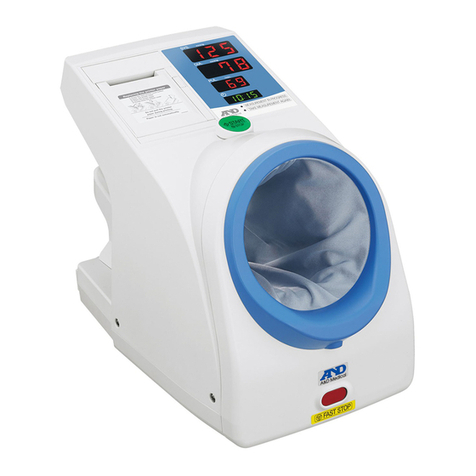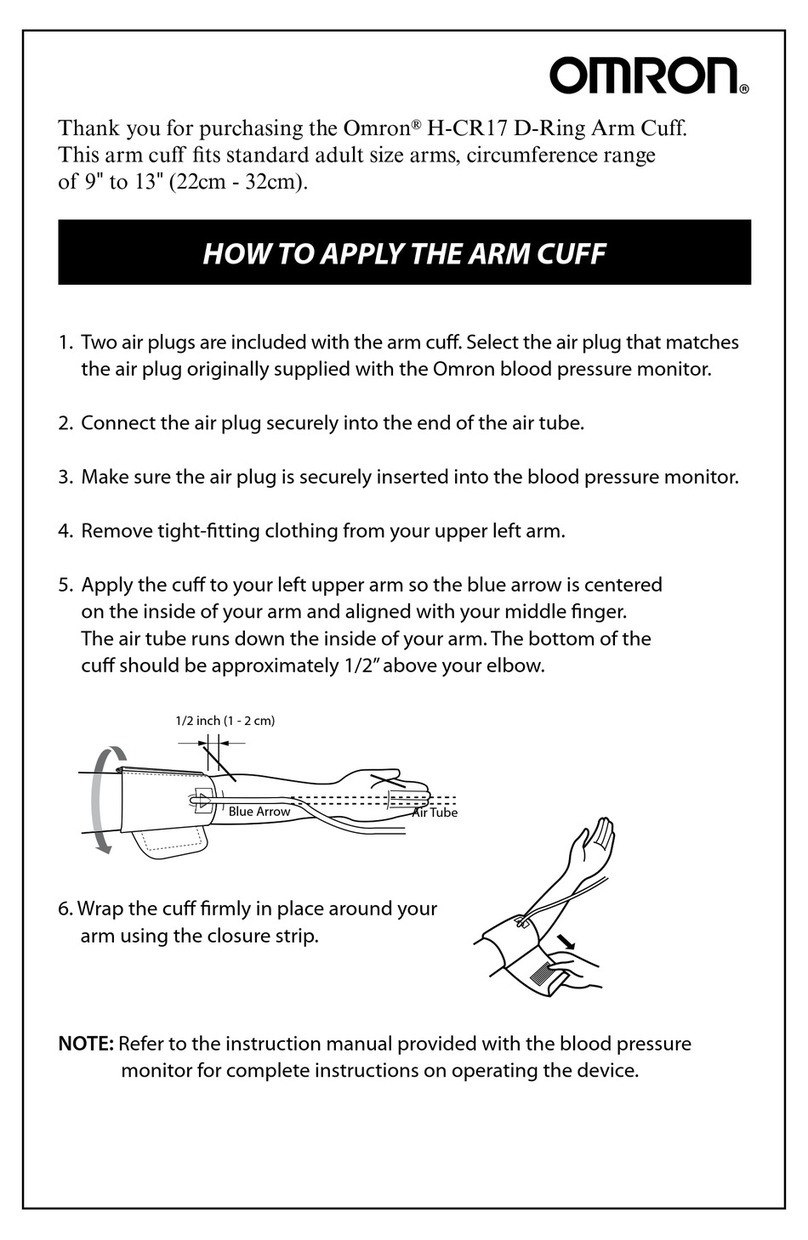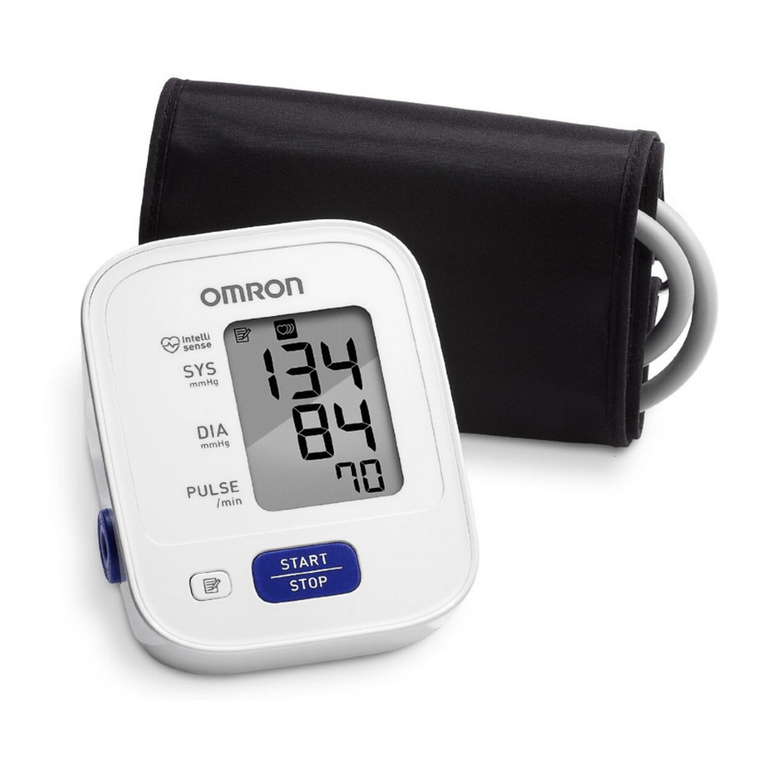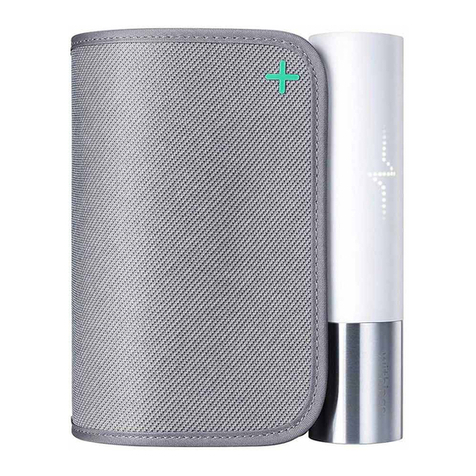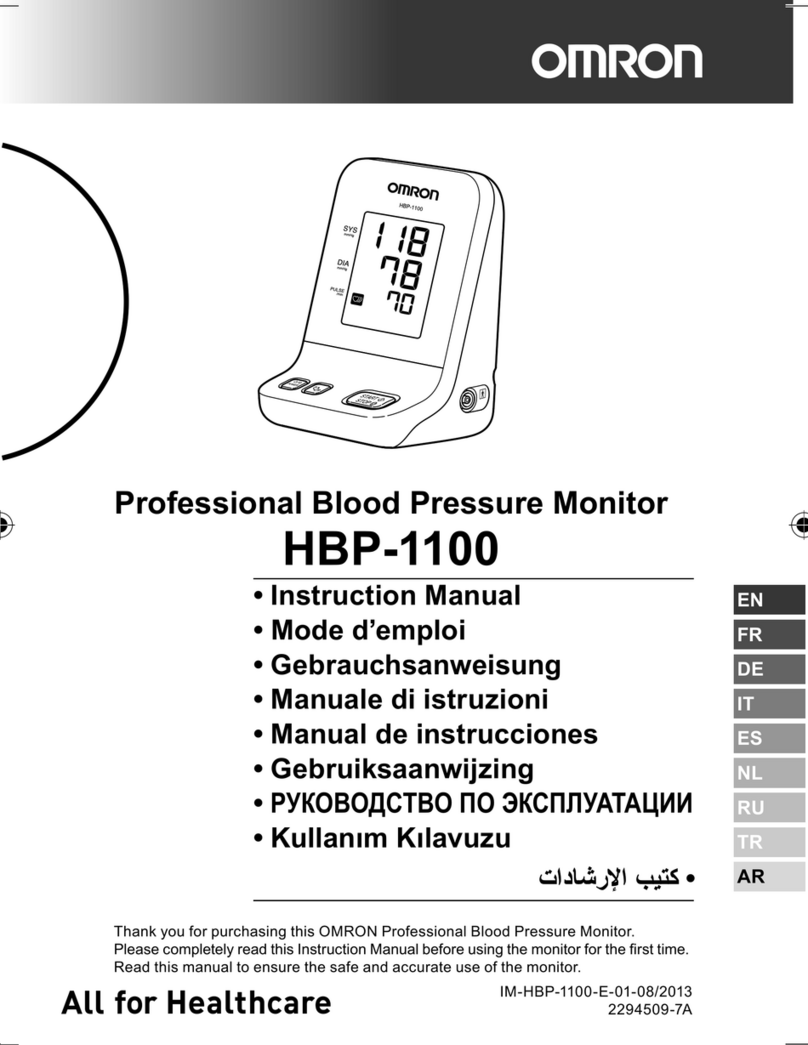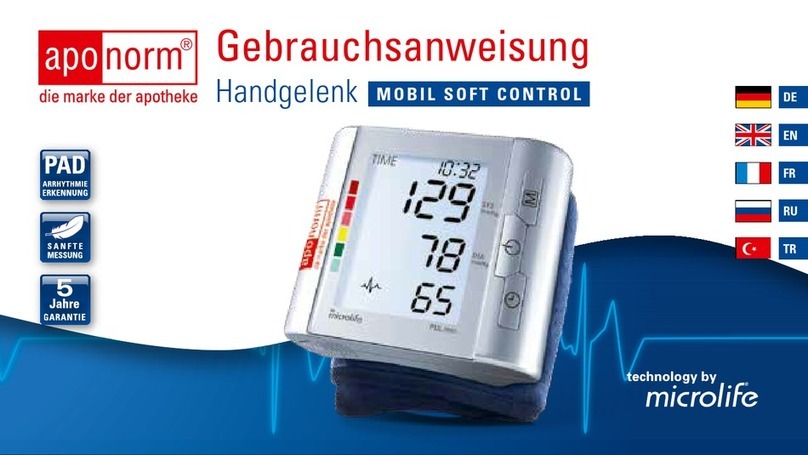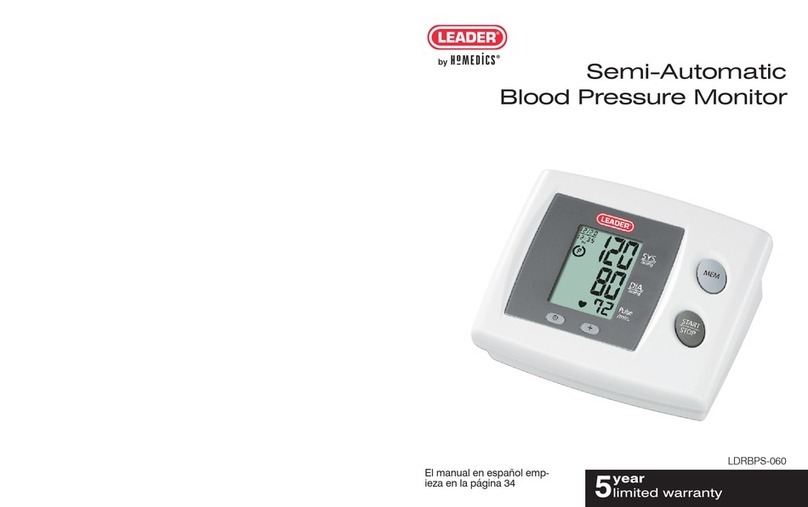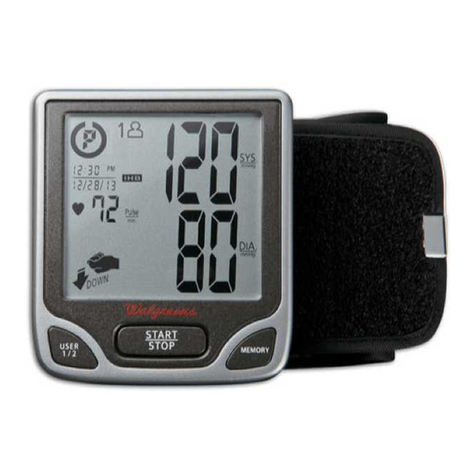Timex HEALTHCARE 80201 User manual

1
INTRODUCTION
Your blood pressure monitor is an automatic digital blood pressure measuring device
for use on the wrist. It enables very fast and reliable measurement of the systolic and
diastolic blood pressure as well as the pulse frequency by way of the oscillometric
method of measuring. Thanks to the large LCD display of BP model #80201 both
operational status and cuff pressure are visible for the entire duration of the measure-
ment. Before using, please read through this instruction manual carefully and then
keep it in a safe place. For further questions on the subject of blood pressure and its
measurement, please consult your doctor.
Important information about self-measurement
• Do not forget: self-measurement means control, not diagnosis or treatment.
Unusual values should be discussed with your doctor. Under no circumstances
should you alter the dosages of any drugs prescribed by your doctor.
• The pulse display is not suitable for checking the frequency of heart pacemakers.
• In cases of cardiac irregularity (arrhythmia), measurements made with this instru-
ment should only be evaluated after consultation with the doctor.
Electromagnetic interference:
The device contains sensitive electronic components (microcomputer). Therefore,
avoid strong electrical or electromagnetic fields in the direct vicinity of the device
(e.g. cellular phones, microwave ovens). These can lead to temporary impairment
of the measuring accuracy.
IMPORTANT INFORMATION ON BLOOD PRESSURE AND
ITS MEASUREMENT
How does high/low blood pressure arise?
Your blood pressure level is deter-
mined in the circulatory center of your brain. Your nervous system allows your body to
adapt or alter blood pressure in response to different situations. Your body alters your
pulse and the width of blood vessels through changes in muscles in the walls of
blood vessels. Your blood pressure reading is highest when your heart pumps or ejects
blood. This stage is called your systolic blood pressure. Your blood pressure is lowest
when the heart rests(in-between beats).This is called your diastolic blood pressure. It
is critical to maintain blood pressure values within a "normal" range(s) in order to
prevent particular diseases.
Which values are normal?
Blood pressure is too high if at rest, the systolic blood
pressure is over 140mmHg and/or the diastolic pressure is above 90mmHg. In this
case, please consult your doctor. Long-term values at this level can endanger your
health due to the associated advancing damage to the blood vessels in your body.
With blood pressure values that are too low, i.e. systolic values under 105 mmHg
and/or diastolic values under 60 mmHg, you should consult your doctor. Even with
normal blood pressure values, a regular self-check with your blood pressure monitor is
recommended. In this way you can detect possible changes in your values early and
react appropriately. If you are undergoing medical treatment to control your blood
pressure, please keep a record of the level of your blood pressure by carrying out reg-
ular self-measurements at specific times of the day. Show these values to your doctor.
Never use the results of your measurements to alter independently the
drug doses prescribed by your doctor.
Further information
• If your values are mostly standard under resting conditions but exceptionally high
under conditions of physical or psychological stress, it is possible that you are
suffering from “labile hypertension” (frequently changing levels of elevated blood
pressure). Please consult your doctor if you suspect that this might be the case.
What can be done, if high/low values are obtained?
a) Please consult your doctor.
b) Increased blood pressure values (various forms of hypertension) are associated long
and medium term with considerable risks to health. This concerns the arterial blood
vessels of your body, which are endangered due to constriction caused by deposits in
the vessel walls (arteriosclerosis). A deficient supply of blood to important organs
(heart, brain, muscles) can be the result. Furthermore, with long-term continuously
increased blood-pressure values, the heart will become structurally damaged.
c) There are many different causes of the appearance of high blood pressure. We dif-
ferentiate between the common primary (essential) hypertension, and secondary
hypertension. The latter group can be ascribed to specific organic malfunctions. Please
consult your doctor for information about the possible origins of your own increased
blood pressure values.
d) There are steps you can take, not only for reducing a medically established high
blood pressure, but also for prevention. These steps must be a part of your general
way of life:
Eating habits
• Strive for a normal weight corresponding to your age
• Avoid excessive consumption of salt
• Avoid fatty foods
Previous illnesses
• Follow consistently any medical instructions for treating previous illness such as:
• Diabetes (Diabetes mellitus)
• Fat metabolism disorder
• Gout
Habits
• Give up smoking completely.
• Drink only moderate amounts of alcohol.
• Restrict your caffeine consumption (Coffee).
Physical constitution
• After a preliminary medical examination, do regular exercise.
• Choose sports which require stamina and avoid those which require strength.
• Avoid reaching the limit of your performance.
• With previous illnesses and/or an age of over 40 years, please consult your doctor
before beginning your sporting activities. He will advise you regarding the type and
extent of types of sport that are possible for you.
COMPONENTS OF YOUR BLOOD PRESSURE MONITOR
The illustration shows the Timex Wrist blood pressure monitor, consisting of:
Blood Pressure
Monitor
Battery Cover
Digital Display
Memory Button
On/Off Button
Automatic Wrist
Model# 80201

2
USING YOUR BLOOD PRESSURE MONITOR
Inserting the batteries
After you have unpacked your device, first insert the batteries.
The battery compartment is located on the underside of the
device (see illustration).
a) Remove cover as illustrated.
b) Insert the batteries 2 x AAA observing the indicated polarity.
c) If the battery warning appears in the display, the batteries
are low and must be replaced by new ones.
Attention
• After the battery warning appears, the device is
blocked until the batteries have been replaced.
• For best results use AAA Alkaline Batteries.
• If the blood pressure monitor is left unused for long periods,
please remove the batteries from the device.
CARRYING OUT A MEASUREMENT
Before the measurement:
• Avoid eating or smoking as well as all forms of exertion immediately before the
measurement. All these factors influence the measurement. Try and find time
to relax by sitting in an armchair in a quiet atmosphere for about ten minutes
before the measurement.
• Remove any garment that fits closely to your wrist.
• Measure always on the same arm (normally left).
• Attempt to carry out the measurements regularly at the same time of day,
since the blood pressure changes during the course of the day.
Common sources of error:
Comparable blood pressure measurements always require the same conditions!
These are the optimal conditions.
• All efforts by the patient to support the arm can increase the blood pressure. Make
sure you are in a comfortable, relaxed position and do not activate any of the mus-
cles in the measurement arm during the measurement. Use a cushion for support if
necessary.
• If the arm artery lies considerably lower (higher) than the heart, an erroneously
higher (lower) blood pressure will be measured! (Each 6 inches (15 cm) difference
in height results in a measurement error of 10 mmHg!)
• With repeated measurements, blood accumulates in the respective arm, which can
lead to false results. Correctly executed blood-pressure measurements should there-
fore first be repeated after a 15 second pause.
Measuring procedure
After the cuff has been appropriately positioned, the measurement can begin:
1. Place the wrist blood pressure monitor on left wrist
with the unit against the inside of your wrist. Make sure
palm is facing up.
2. Securely wrap and fasten the hook & loop fabric
securely on wrist.
3. Make sure that the monitor is at heart level. This is
approximately 1"-2" above the bottom of your sternum.
4. Press the "ON/OFF" button to turn the power on. A
flashing "0" will appear. Remain still and do not speak
until the measurement is complete.
5. The wrist-cuff will automatically inflate and a "P" will
appear on the monitor. As the wrist cuff deflates, the
monitor will make a short beeping sound and a flashing heart
symbol will appear on the LCD panel. The wrist cuff will inflate
until the compression temporarily stops the blood flow through
the artery in your wrist. Numbers on the face of the screen will
begin to count backwards and the compression around the
wrist will simultaneously decrease.
6. When the reading is completed the monitor will make a
longer beeping sound and the wrist cuff will deflate completely.
7. Turn the unit off by pressing the "ON-OFF" button. If the unit is not turned off, it
will automatically shut off in 3 minutes. (The measurement will automatically be
placed into memory).
8. Press the "MEMORY" key to recall the measurement from memory. To view previ-
ous readings depress the MEMORY button repeatedly or hold down to scan. The most
recent measurement will always appear first.
9. The unit has the capacity to store 60 blood pressure measurements. Once capacity
has been reached, it will begin to replace measurements as they are stored.
10. Place into storage case.
Discontinuing a measurement
If it is necessary to interrupt a blood pressure measurement for any reason (e.g. the
patient doesn’t feel well), press the “ON/OFF” button. The device then immediately
lowers the cuff-pressure automatically.
CARE AND MAINTENANCE
a) Do not expose the device to extreme temperatures, humidity, dust or direct sun-
light.
b) The cuff contains a sensitive air-tight bubble. Handle this carefully and avoid all
types of straining through twisting or buckling.
c) Clean the device with a soft, dry cloth. Do not use gas, thinners or similar solvent.
Spots on the cuff can be removed carefully with a damp cloth and soapsuds.
The cuff must not be washed!
d) Do not drop the instrument or treat it roughly in any way. Avoid strong vibrations.
e) Never open the device! Otherwise the manufacturer warranty becomes invalid!
TECHNICAL SPECIFICATIONS
Name TIMEX Automatic Wrist Blood Pressure Monitor
Model 80201
Measurement Oscillometric
Measurement Range Pressure: 20-280mmHg - Pulse Rate: 40-
195 beats/min
Accuracy Pressure: within ±3mmHg - Pulse Rate: within
±5% of reading (Subject to the temp. humidity
listed below)
Inflation Automatic inflation with pump
Pressure Detection Semi –Conductor
Power Supply 2 "AAA" Alkaline Batteries
Auto Power Off 3 minutes after last key operation
Operating Temperature/ Humidity 50˚F ~ 104˚F (+10°C to +40°C) / 30% to 85% RH
Storage Temperature/Humidity -4˚F ~ 118˚F (-20°C to +48°C)/ 10% to 95% RH
Weight of Main Unit Approximately 4.8 ounces (including batteries)
External Dimensions 3(L) x 3(H) x 2.5(D) inches
Wrist Circumference 5.3 in ~ 8.6 in (135mm - 220mm)
Lo-Battery Warning
ERROR MESSAGE/MALFUNCTIONS
Action
Nothing displayed
when you push the
start button.
"Err P" is shown
on LCD panel.
"Err 1" is shown
on LCD panel.
"Err 2" is shown
on LCD panel.
"Err 5" is shown on
LCD panel
Problem
Are the batteries good?
Are the batteries in backwards?
Fail to inflate?
Deflates too fast?
1. Was the wrist moved
during testing?
2. Was there interference
to signal of monitor?
Incorrect result?
Solution
Replace the batteries
Insert batteries per engraved polarity
diagram in battery compartment.
Please check to see if the cuff is too
loose. If so, fasten it more tightly.
Call customer service
1-800-422-0360
1. Keep still after you push the
“ON/OFF” button.
2. Please remove interfering sources
such as magnets, or cell phones.
1. The cuff might be placed on your
wrist incorrectly. Please re-wrap the
cuff in the correct position.

3
WARRANTY
Your TIMEXTM Automatic Wrist Blood Pressure Monitor is a durable and precise med-
ical device manufactured under license by MEDport, LLC. MEDport takes pride in the
quality and workmanship crafted into every product made. Accordingly, MEDport will
repair or replace at our option any product that is defective in material or workman-
ship for three years. This warranty does not cover the batteries or damage caused by
accident, negligence or improper use or care. Please take a moment to mail in the
enclosed warranty card now. It will expedite any claims you may have against this
warranty in the future.
Product should be returned to MEDport, LLC., postage prepaid with proof of purchase
and an explanation of the problem. If you follow the instructions for proper use and
care, the TIMEXTM Automatic Wrist Blood Pressure Monitor should last for years.
However, if for any reason you are not satisfied, call our toll-free customer service
line: 1.800.422.0360. Our hours of operation are Monday – Friday 8:00 a.m. – 8:30
p.m. EST.
Manufactured and Distributed under license by:
MEDport, LLC.
23 Acorn Street
Providence, RI 02903
1-800-299-5704
email: [email protected]
www.timexhealthcare.com
Detailed user information about our thermometers and blood pressure monitors as
well as services can be found at www.timexhealthcare.com.
TIMEX is a trademark of Timex Corporation.
Other Timex Blood Pressure Monitor manuals





